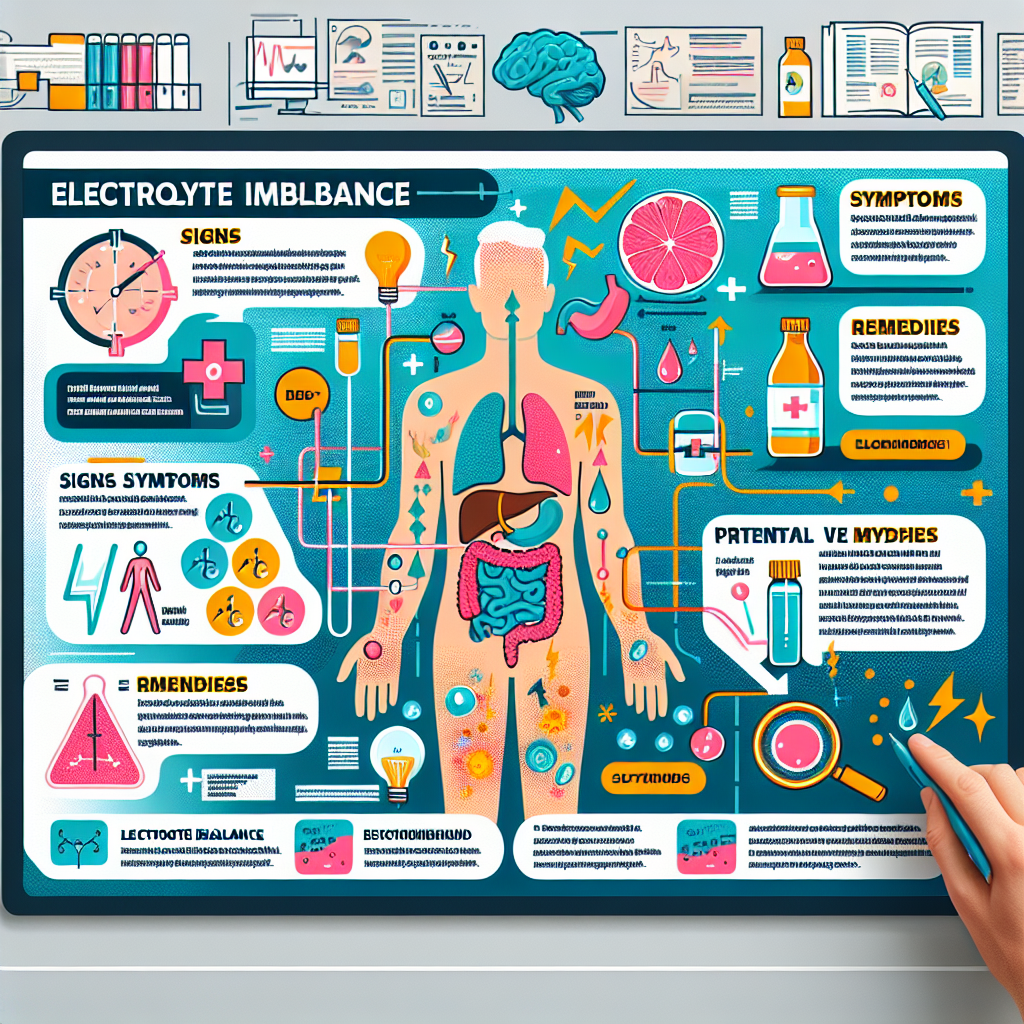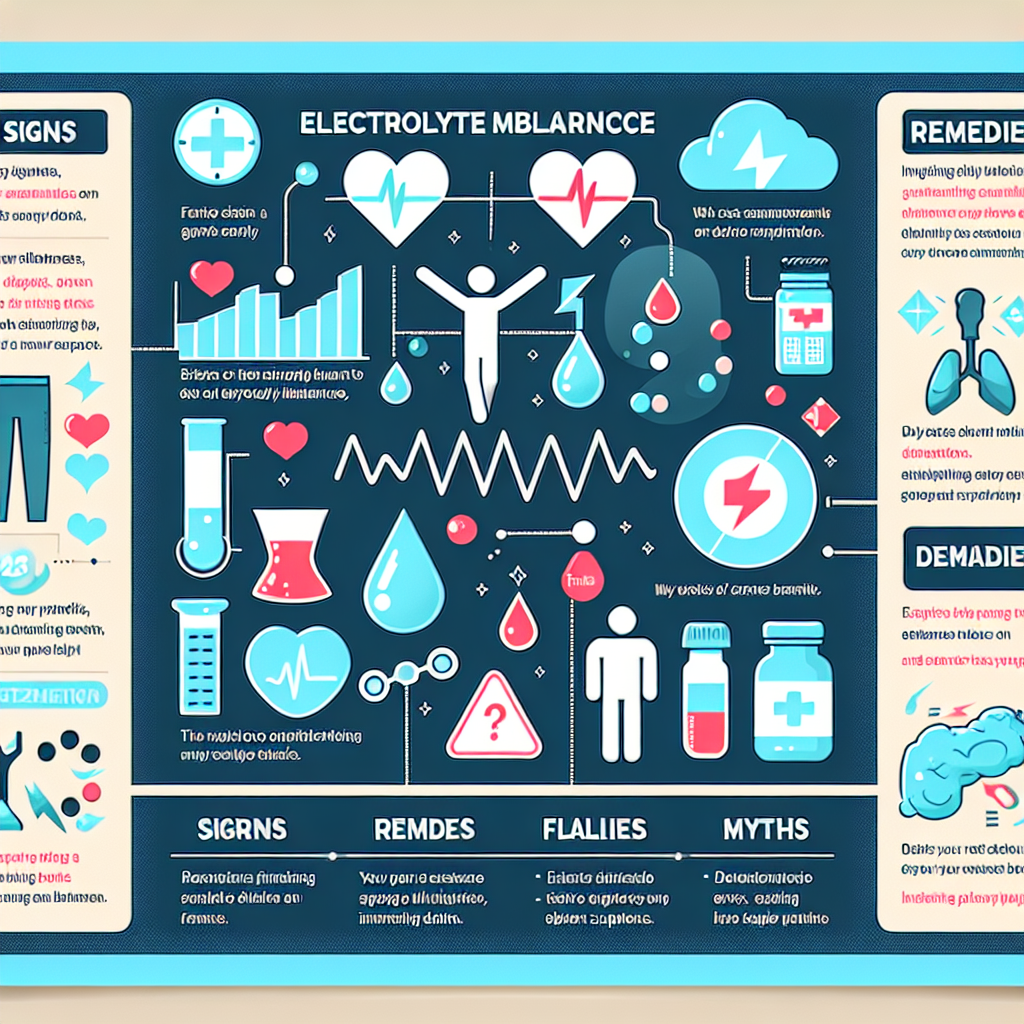Electrolyte Imbalance: Signs, Fixes, and Myths

Discover more about Electrolyte Imbalance: Signs, Fixes, and Myths. Learn how to identify the symptoms, understand the myths, and find effective solutions. Empower your health knowledge now. Visit My Vibrant Vitality for more information.
Understanding the Signs of Electrolyte Imbalance: A Comprehensive Guide
Electrolyte imbalance is a condition that often goes unnoticed until it becomes severe. It is a critical health issue that can lead to serious complications if not addressed promptly. Understanding the signs of electrolyte imbalance is the first step towards managing this condition effectively.
Electrolytes are minerals that carry an electric charge and are essential for various bodily functions. They help regulate nerve and muscle function, hydrate the body, balance blood acidity and pressure, and help rebuild damaged tissue. The body’s primary electrolytes include sodium, potassium, calcium, bicarbonate, magnesium, chloride, and phosphate. An imbalance occurs when the concentration of any of these electrolytes becomes too high or too low.
The signs of electrolyte imbalance can be subtle and may be easily mistaken for symptoms of other health conditions. Common symptoms include irregular heartbeat, fast heart rate, fatigue, lethargy, convulsions or seizures, nausea, vomiting, diarrhea or constipation, abdominal cramping, muscle weakness, muscle cramping, irritability, confusion, headaches, numbness and tingling. In severe cases, electrolyte imbalance can lead to bone disorders, nervous system disorders, heart disease, and even death.
Fixing an electrolyte imbalance involves identifying the underlying cause and treating it. This could mean adjusting your diet to include more or less of certain foods, taking supplements, or in severe cases, receiving intravenous (IV) fluids or medications. For instance, if you have low levels of potassium, you might need to eat more potassium-rich foods like bananas, oranges, and spinach. If your calcium levels are too high, you might need to cut back on dairy products and take a calcium binder.
However, it’s important to note that self-diagnosis and treatment can be dangerous. If you suspect you have an electrolyte imbalance, it’s crucial to seek medical advice. A healthcare professional can accurately diagnose your condition and recommend the appropriate treatment.
There are several myths surrounding electrolyte imbalance that can lead to confusion. One common myth is that only athletes need to worry about electrolyte balance. While it’s true that athletes are at a higher risk due to the large amounts of water they lose through sweat, anyone can experience an electrolyte imbalance. Dehydration, poor diet, certain medications, kidney disease, and other health conditions can all lead to electrolyte imbalances.
Another myth is that all electrolyte drinks are beneficial. While sports drinks can help replenish electrolytes lost during intense exercise, they often contain high levels of sugar and calories. For most people, a balanced diet and regular water intake are sufficient to maintain electrolyte balance.
In conclusion, understanding the signs of electrolyte imbalance is crucial for maintaining good health. If you experience symptoms such as fatigue, muscle cramping, or irregular heartbeat, it’s important to seek medical advice. While certain lifestyle changes can help prevent electrolyte imbalances, it’s essential to debunk the myths surrounding this condition and understand that anyone can be affected. With the right knowledge and approach, electrolyte imbalance can be effectively managed and treated.
Effective Fixes for Electrolyte Imbalance: A Step-by-Step Approach

Electrolyte imbalance is a condition that occurs when the concentration of electrolytes in your body is either too high or too low. Electrolytes are minerals that conduct electricity when dissolved in water. They are essential for a variety of bodily functions, including maintaining fluid balance, regulating heart and muscle function, and transmitting nerve impulses. When an imbalance occurs, it can lead to a variety of symptoms and health problems.
The first step in addressing an electrolyte imbalance is to identify the signs. These can vary depending on which electrolytes are out of balance, but common symptoms include irregular heartbeat, fatigue, nausea, constipation or diarrhea, muscle cramping or weakness, and changes in blood pressure. If you’re experiencing any of these symptoms, it’s important to seek medical attention.
Once an electrolyte imbalance has been diagnosed, the next step is to determine the cause. This can often be traced back to an underlying health condition, such as kidney disease or heart failure, or to certain lifestyle factors, such as a poor diet or excessive alcohol consumption. In some cases, an electrolyte imbalance can also be caused by certain medications.
Once the cause has been identified, treatment can begin. This typically involves addressing the underlying cause and restoring the balance of electrolytes in the body. This can often be achieved through dietary changes, such as increasing the intake of foods rich in the deficient electrolytes. For example, if you’re low in potassium, you might be advised to eat more bananas, oranges, and potatoes. If you’re low in magnesium, you might need to consume more green leafy vegetables, nuts, and seeds.
In some cases, dietary changes may not be enough, and medication or intravenous (IV) therapy may be required. This is particularly true in severe cases, where the imbalance is causing serious symptoms or health problems.
While addressing an electrolyte imbalance, it’s also important to debunk some common myths. One such myth is that sports drinks are the best way to replenish electrolytes. While these drinks do contain electrolytes, they also often contain high amounts of sugar and artificial ingredients, which can actually exacerbate an imbalance. A healthier alternative is to drink water and eat a balanced diet rich in whole foods.
Another myth is that all electrolyte imbalances are caused by dehydration. While it’s true that dehydration can lead to an imbalance, it’s not the only cause. As mentioned earlier, underlying health conditions, poor diet, and certain medications can also lead to an imbalance.
In conclusion, addressing an electrolyte imbalance involves identifying the signs, determining the cause, and implementing a treatment plan that may involve dietary changes, medication, or IV therapy. It’s also important to dispel common myths and understand that maintaining a balanced diet and staying hydrated are key to preventing an imbalance. If you suspect you have an electrolyte imbalance, seek medical attention promptly. With the right approach, an electrolyte imbalance can be effectively managed and even prevented.
Debunking Myths Surrounding Electrolyte Imbalance: Facts vs Fiction
Electrolyte imbalance is a condition that has been widely discussed, yet it is often misunderstood. This is largely due to the numerous myths that surround it. In this article, we will debunk some of these myths and provide factual information about electrolyte imbalance, its signs, fixes, and the reality behind the fiction.
One of the most common myths is that electrolyte imbalance only occurs in athletes or those who engage in strenuous physical activities. While it’s true that athletes are at a higher risk due to excessive sweating, anyone can experience electrolyte imbalance. Factors such as diet, illness, medications, and age can all contribute to an imbalance. Therefore, it’s crucial for everyone, not just athletes, to understand the signs of electrolyte imbalance.
The signs of electrolyte imbalance can vary greatly depending on which electrolytes are out of balance. Common symptoms include irregular heartbeat, fatigue, nausea, constipation or diarrhea, muscle cramping, and changes in weight. In severe cases, it can lead to seizures, bone disorders, and even heart failure. Contrary to the myth that electrolyte imbalance is not a serious condition, it can indeed have severe health implications if left untreated.
Another myth is that drinking lots of water can prevent electrolyte imbalance. While staying hydrated is important, drinking excessive amounts of water can actually lead to a condition called hyponatremia, a type of electrolyte imbalance where sodium levels in the body are dangerously low. This is because water dilutes the concentration of electrolytes in the body. Therefore, it’s not just about the quantity of water you drink, but also maintaining a balance of electrolytes.
Fixing an electrolyte imbalance involves more than just drinking sports drinks, another common myth. While sports drinks do contain electrolytes, they also often contain high levels of sugar and calories. A healthier approach would be to consume a balanced diet rich in fruits, vegetables, dairy products, and lean proteins, all of which naturally contain electrolytes. In some cases, a doctor may recommend electrolyte supplements or intravenous (IV) electrolyte solutions.
The myth that all electrolyte supplements are the same also needs debunking. Different supplements contain different types and amounts of electrolytes. For instance, some might be high in sodium, while others might be high in potassium or magnesium. It’s important to choose a supplement that fits your specific needs. Consulting with a healthcare provider can help determine which supplement is right for you.
Lastly, there’s a myth that you can self-diagnose an electrolyte imbalance. While being aware of the symptoms is important, only a healthcare provider can accurately diagnose this condition through blood tests. If you suspect you have an electrolyte imbalance, it’s crucial to seek medical attention.
In conclusion, understanding the facts about electrolyte imbalance is key to maintaining good health. It’s not a condition that only affects athletes, it’s not prevented by drinking lots of water, and it’s not fixed by simply consuming sports drinks. It’s a serious condition that requires a balanced diet, possibly supplements, and definitely medical attention if suspected. By debunking these myths, we can better understand and manage electrolyte imbalance.